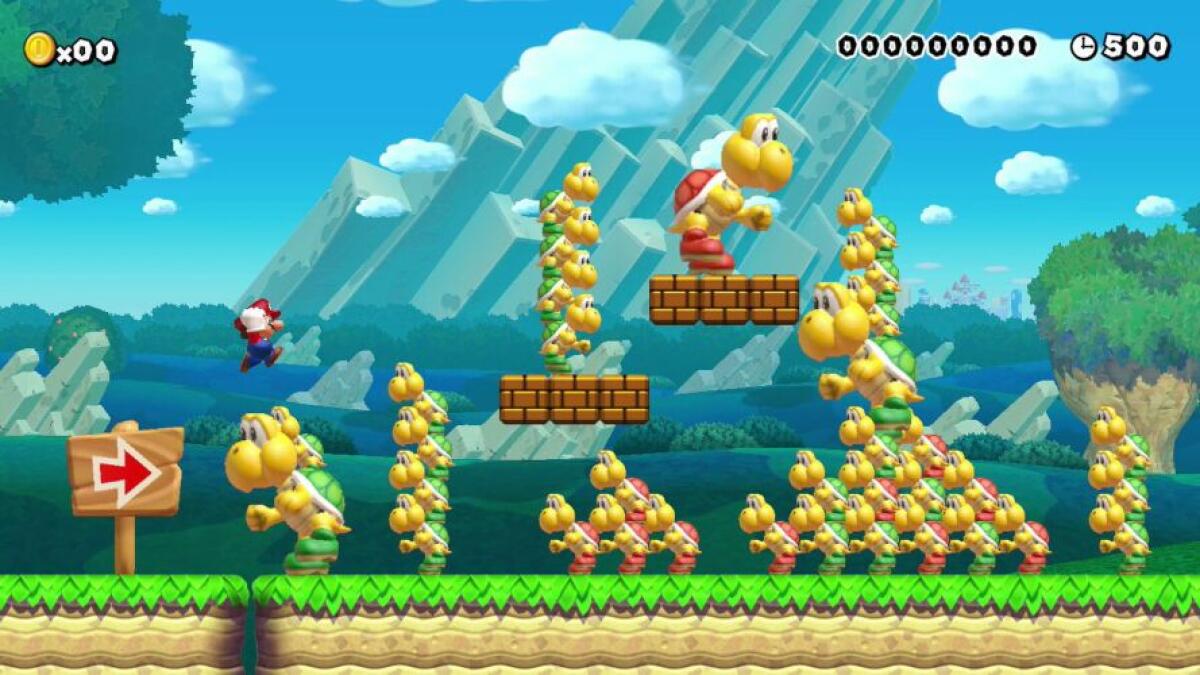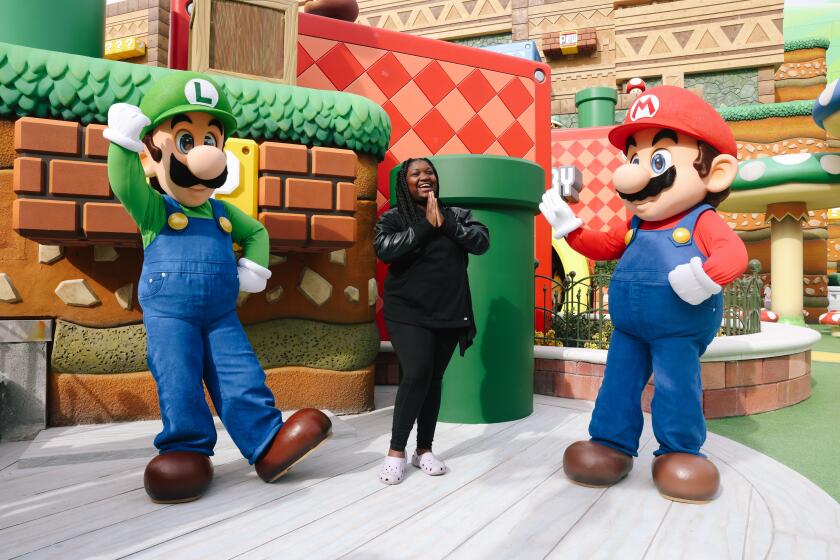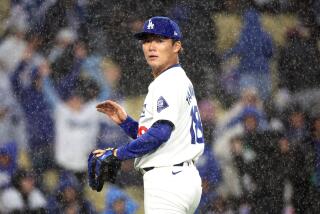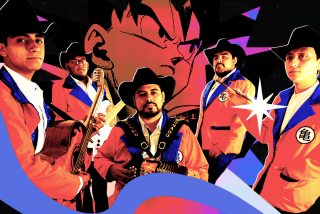The Player: ‘Super Mario Bros.’ at 30: The plump plumber who changed gaming

- Share via
Thirty years ago a plump little plumber in red overalls revolutionized gaming.
On Sept. 13, 1985, Nintendo released “Super Mario Bros.,” the signature title in what would become the company’s blockbuster home video game console, the Nintendo Entertainment System.
Fame has treated Mario well.
Three decades on, the character drawn up by game design master Shigeru Miyamoto is still immediately identifiable. And his games regularly sell in the multiple millions. What’s the secret?
“It was the big nose and the mustache,” says Miyamoto, short, trim and still prone to playfulness in his early 60s. Mention, for instance, Mario’s recent ability to transform into a feline in “Super Mario 3D World,” and Miyamoto is likely to mimic having cat ears.
Miyamoto, says Charles Pratt, a game designer who teaches at NYU’s Game Center, is “like the jazz pianist who hits only the notes he absolutely has to. He gets so much out of so little. That’s why the games are amazing.”
In the early ‘80s, games meant Atari, arcades, “Space Invaders,” “Pac-Man.” It took Mario to give gamers a recognizable character on par with Mickey Mouse.
Today, it’s PlayStation, Xbox, “Halo,” “Metal Gear.” Mainstream video games require hours simply to learn and are often dependent upon complex control schemes involving a dozen-plus buttons.
Mario? He runs and he jumps.
Universal Studios Hollywood’s Super Nintendo World -- home to the ride Mario Kart: Bowser’s Challenge -- promises to be the most interactive theme park land ever created.
“You can talk about his effect on the game industry, but he is the game industry,” says Yusuke Hashimoto, a developer at Platinum Games working with the Nintendo master on the upcoming Wii U title “Star Fox Zero.”
On Friday, nearly 30 years after the first “Super Mario Bros.,” Nintendo released “Super Mario Maker,” a game that allows fans to create levels for a number of breakthrough titles in the “Super Mario Bros.” series. It bears many of the hallmarks of a game overseen by Miyamoto, an artist whose résumé includes other household names such as “Donkey Kong” and “The Legend of Zelda.”
Miyamoto’s games are typically friendly, warm and incredibly deep, but also stunningly simple to grasp. “Mario Maker” players will find themselves tinkering with the game’s fantastical worlds in moments — a gold star in a castle, a Goomba on a ship, a perilous squid underwater.
“Mr. Miyamoto is a wonderful teacher,” says Richard Lemarchand, a game designer and associate professor at USC Games.
“When one approaches one of his games, the game is welcoming to you. It gives you time and space to orient yourself to the game. It teaches, not in a didactic way — not by lecturing you, not by presenting you with mundane tutorials — but it teaches you simply by allowing you to play.”
Take the first level of “Super Mario Bros.” Look, over there. It’s a walking brown mushroom. Can Mario touch it? No, he dies. What if Mario jumps on it? Viola, that worked. Now there’s a blinking box above Mario. Maybe hit it with his head? That unleashes another mushroom, this one with red polka-dots. It’s running away from Mario. Grab it?
“One of the things I really love about the original ‘Super Mario Bros.’ is how bizarre and surreal it is and no one seems to notice,” Pratt says. “I think it’s truly brilliant on Miyamoto’s part. He wanted to make a great game about jumping on things, but that doesn’t make any sense.”
At least outside of a childhood playground, which is often cited as a prime source of Miyamoto’s inspiration.
The second lesson of “Mario Maker” is that it’s relatively easy to create a challenging world. Throw some flaming blades around moving platforms, add hammer-tossing turtles, finish it off with a maze of angry spiked blocks and you have instant frustration.
It’s a lot more difficult to create a level on a curve, one that creates a natural evolution of brain teasers for the player.
“Game makers oftentimes get stuck in a sense of only being able to see the game from the developer’s perspective,” says Nintendo’s Yugo Hayashi, who reports to Miyamoto on the development of “Star Fox Zero.”
“Mr. Miyamoto,” Hayashi continued, “is very good at being able to switch to the player or user’s perspective. He notices everything. He notices what small adjustments need to be made to make the game more playable and easier to understand. If I’m ever making a game and there’s part that I’m not sure about, that’s always the part that he immediately keys in on. It’s kind of scary, actually.”
Mario didn’t begin as Mario.
The character was first seen in Nintendo’s 1981 surprise arcade smash “Donkey Kong,” which sprang from the imagination of Miyamoto when he was a young staff artist at Nintendo.
“The very first game that I made, I drew the Mario character for that game,” says Miyamoto, speaking through a translator.
“That was ‘Donkey Kong’ of course, and in Japan there were many comic artists who at the time would have a particular character they would draw in all of their different comics. So when I drew that Mario for the very first time, I thought, ‘Oh, I like this character. I want to use him in all of my games going forward.’ At the time, I was calling him Mr. Video, for video games.”
Mr. Video, also known as Jumpman and eventually Mario, a name he took from a former Nintendo of America warehouse landlord, was the result of technological limitations of the era.
“Back then, we had a very small amount of space with which to draw the character,” Miyamoto says. “The original Mario design was just in a space that was 16 dots by 16 dots. Within that limited palate, I felt I was able to draw a character who was quite unique and recognizable and took up very little space on the screen. You could look at him, and instantly know who he was.”
There were other ingredients that played a part in Mario’s lasting success. “Mr. Miyamoto’s image for an action-game character was that he should be someone blue-collar,” Nintendo’s long-time designer and “Mario Maker” producer Takashi Tezuka tells me in an email interview.
Mario, therefore, became someone to root for, a chubby guy whose princess was often just out of reach.
“He’s not a threatening figure,” says John Sharp, an associate professor Parsons School of Design at The New School. “He’s a little pudgy dude in overalls. In that respect, he’s very inviting to people. There’s something about being the underdog, perhaps, wrapped up in that. This underdog with fantastic powers and a limitless will and drive to pursue his goals.”
An emphasis on broadly drawn characters was also a rarity for games in the early ‘80s, which relied heavily on symbols or spacecraft (see “Space Invaders,” “Galaxian” or Nintendo’s own pre-”Donkey Kong” title “Radar Scope”).
“Previous to ‘Donkey Kong,’ they’re not really character-based games, unless you have a static character talking at you,” says Jennifer DeWinter, an associate professor at Worcester Polytechnic Institute and author of “Shigeru Miyamoto,” the first in a planned series from Bloomsbury on influential video game designers.
“Miyamoto has a very human sensibility,” says USC’s Lemarchand. “That is part of what orients him toward character as a crucially important aspect, maybe the fundamental aspect of storytelling.”
An Everyman appeal has been key to Mario and Nintendo’s longevity.
“Their ability to hit this massive audience is unparalleled,” DeWinter says. “Nintendo had come out against Atari and against Sega and against all the competition and said, ‘We’re not interested in defining a core. We’re interested in ensuring that Aunt Flo will play.’”
DeWinter compares Miyamoto to Japanese animation legend Hayao Miyazaki, noting that a magical view of nature figures heavily into many of their works, be it the labyrinth-like caves of the “Zelda” series, the sci-fi gardens of “Pikmin” or the castles amid the forests of the “Super Mario Bros.” games.
In game design circles, Miyamoto’s childhood has become the stuff of legend. Born in 1952 in Sonobe, Kyoto, the young Miyamoto spent his days exploring the countryside and caverns of his hometown.
“Famously, Mr. Miyamoto is very influenced by his life experiences in the creation of his games, particularly his experiences in nature,” says Lemarchand. “As video games evolve and mature, the inspiration for great games comes from everywhere in life. It comes from family and books and cooking and childish games and adult leisure pursuits. These are rich terrain for the development of new kinds of video games. It’s perhaps natural that Mr. Miyamoto has always led the field in this regard.”
Led, and continues to push against the grain.
Miyamoto recalls that Mario, at the height of his popularity in the mid-’80s, was deemed as recognizable a figure as Mickey Mouse. That gave him something of a mission.
“Mickey Mouse sort of grew and evolved alongside cartoons and animation. I felt it would be best for Mario to grow and evolve alongside video games. Whenever we introduced new technology, we always paired that introduction with a new Mario game, so that was how Mario evolved alongside games.”
This month’s biggest game is arguably Konami’s “Metal Gear Solid V: The Phantom Pain,” a convoluted militaristic exercise in stealth and gunplay It’s so byzantine that Pratt, who earlier compared Miyamoto to a jazz musician, describes the new “Metal Gear” as the “Wagnerian opera of video games.” So then what is “Super Mario Bros.”? Pratt doesn’t hesitate: “Really brilliant pop songs.”
And they almost always endure.
More to Read
The biggest entertainment stories
Get our big stories about Hollywood, film, television, music, arts, culture and more right in your inbox as soon as they publish.
You may occasionally receive promotional content from the Los Angeles Times.












